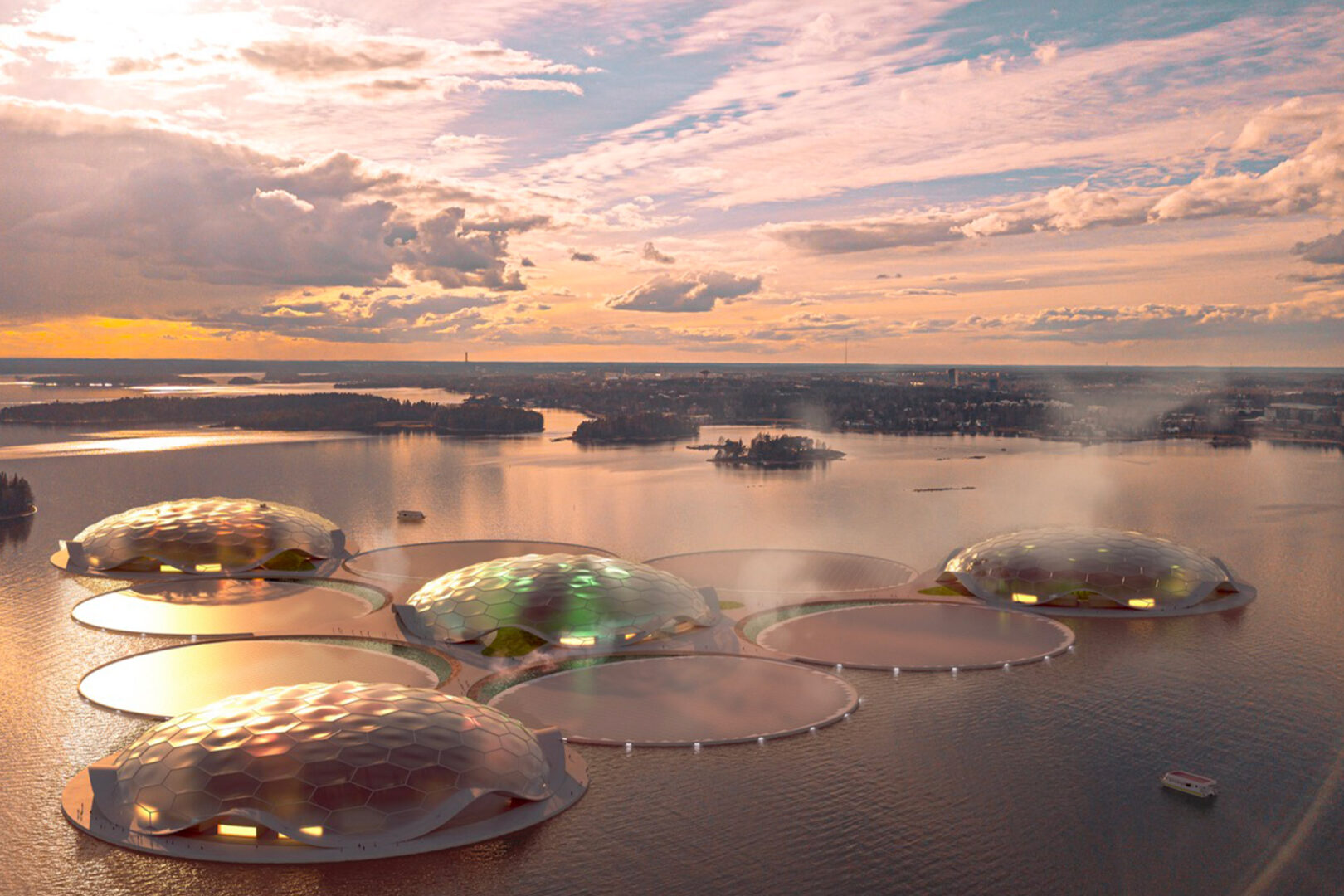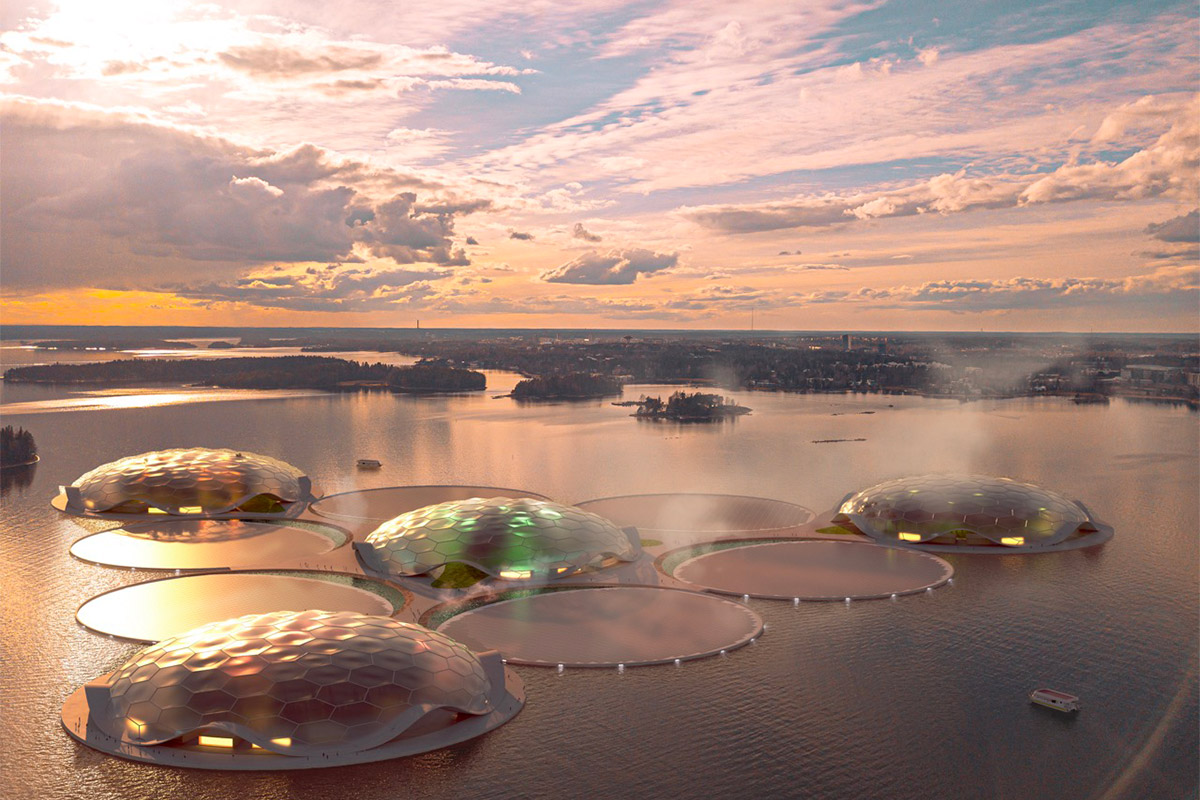Islands designed by Carlo Ratti Associati won the Helsinki Energy Challenge for their contributing to the thermal heating system while avoiding the use of coal
The goal of a carbon neutral Helsinki by 2035 – Hot Heart
Helsinki is among the cities leading sustainable development. Aware of the urgency of implementing an action plan that focuses primarily on decarbonization. The goal set is to be carbon neutral by 2035. Since 2017, several strategies have been deployed involving transportation as well as the energy efficiency of buildings.
Another crucial point is the need to replace heating from carbon; since more than half of the city’s warmth is generated by coal now. The goal set includes not only eliminating this system, but also burning as few biomasses as practicable in the process.
That is why the Helsinki Energy Challenge was launched to answer the question. «How can we decarbonize the heating of Helsinki, using as little biomass as possible?», can be read on the website.
The idea of Hot Heart proposed by CRA-Carlo Ratti Associati won the challenge. Developed in collaboration with Ramboll, Transsolar, Danfoss Leanheat®, Schneider Electric, OP Financial Group, schlaich bergermann partner, and Squint/Opera.
From the application stage, the relevance of heating system replacement
As early as early 2020, the application phase to participate in the Helsinki Energy Challenge began; then continued with a series of meetings and webinars. After that, there were clarifications to participants’ most common questions until the application deadline.
Following this step, the selected finalists were invited to attend a co-creation phase and a boot camp in Helsinki. To then have in early 2021 the selection and awarding of the winners, in this case CRA project. The goal, explains the mayor of Helsinki, Jan Vapaavuori, was to begin to find the solution to climate change that affects cities by resulting in a global crisis.
He goes on to say that there are no quick fixes. Which is why the challenge was looking for new ideas capable of even changing the status quo. For that reason, it starts right from the district heating system. So as to try to propose a sustainable solution that can be replicated in other urban areas as well.
The conception of Hot Heart
The design firm came up with an archipelago consisting of several islands. Capable of storing thermal energy but also serving as a center for recreational activities. A transdisciplinary team was responsible for the development. Together they studied an alternative method of providing a complete replacement for combustion.
In fact, the storage reservoirs of the individual islands are equipped to retain the amount of heat required for the city’s needs. Moreover, having also been designed as centers for people’s activities. These will be home to tropical forests and ecosystems from around the world.
The design of this system provides not only support for the decarbonization process. It also creates an additional public and educational space in Helsinki. Hot Heart began to enter the general planning phase in 2021, while it is expected to be completed by 2028.
The positioning and technicalities
Hot Heart represents the largest infrastructure facility of its kind. Its location off the coast of Helsinki is essential to the functioning of the installation. The archipelago described above consists of a set of ten basins with a cylindrical shape. In particular the diameter of each one measures 225 meters.
In the aggregate, the system is designed to be able to hold up to ten million cubic meters of water. Its operation allows energy storage as if it were a giant thermal battery, explains the Ratti study. Converting renewable energy at no or minimal cost. In addition, essential to operation is the AI control system that enables the entire Helsinki district to be reached.
And CRA goes on to point out that the system operated by artificial intelligence manages to keep the production and consumption of thermal energy synchronized. Based on fluctuations in supply, it then is capable of stabilizing the national energy network.
According to calculations made by the project’s conceptualization; this system should be able to cover Helsinki’s entire heating needs of about 6,000 GWh by the end of the decade. All this is possible without any carbon emissions and at costs about ten percent lower than the current heating method.
Functioning and distribution of the heat storage
According to studies carried out on the project by CRA-Carlo Ratti Associati; this installation could even make Helsinki a pioneering city. Although the decarbonization plan is set for 2035, through this system the operation could be completed in 2028.
That is, several years ahead of the deadline, which could set an example for other cities likewise affected by heat consumption. The Hot Heart project, the study explains, grew out of a focus on renewable energy. In particular, its operation uses a diverse mix of biomass, eolic, hydro, and solar.
«It proposes an innovative solution to the intermittent nature of renewables by developing a new type of thermal storage», they point out. The first step is to use energy from renewable resources when they are copious and inexpensive. The second shift uses seawater in order to be able to turn this energy into heat.
Again, through those marine water heat pumps, this is transported to the Hot Hearts and stored here for when it is required. As a thermal storage battery, CRA-Carlo Ratti Associati reiterates. At the end of the process, it is transferred from this point to the city’s heating distribution service; with the possibility of reaching the entire Helsinki district.
A space designed for city residents
Hot Heart represents not only a heat storage system but also an accessible recreational space for the city of Helsinki. Of the ten tanks that make up the system, as many as four are designed to create a gathering space and a tourist attraction of their own.
Through the use of a network of transparent domes, each of these islands houses what has been called a ‘Floating Forest’. Inside the cupola, in fact, there are tropical ecosystems typical of major rainforest areas around the world. The maintenance of these is possible thanks in particular to the natural warming of the storing basins below.
The space, designed for the Nordic country, allows citizens to take advantage of a place where they can both socialize and benefit from sunlight. This, indeed, is scarce during winter and is recreated in an artificial way through LED technology that emulates solar lighting.
«Hot Heart offers a unique experience, bringing the natural and artificial worlds together. It is inspired by the Finnish concept of Jokamiehen Oikeudet; which could be translated as ‘every person’s right’: the right to reflect and unwind while peacefully enjoying nature», the CRA highlights.
In addition to being a crucial point for Helsinki’s social development, it also represents the possibility of attracting international travelers.
Lampoon reporting: why to replicate the Hot Heart system?
High heat-consuming cities, such as Helsinki, still rely on the extensive usage of coal. The system developed by CRA-Carlo Ratti Associati may represent an ally to decarbonization because it is replicable in other similar contexts.
The utilization of renewable energy, which is the basis of its operation; can have little or no cost, in contrast to the carbon heating systems. Considering just the opportunity to harness natural agents to their maximum potential energy and then save it for the moments of actual necessity.
This benefit also extends to the final consumer who will be able to use the warming facility at lower prices. Most important, the value calculated by the study at the end of the process is of zero carbon footprint. «Production of renewable energy is getting cheaper, but storage is still extremely expensive. Our idea is to use the giant ‘thermal batteries’ to store energy when prices are at low. Or even negative levels and extract it when required by the district heating system when demand is high. This model would also be applicable to many coastal cities with similar climates», affirms Carlo Ratti, founding partner of CRA.
CRA-Carlo Ratti Associati
Based on Carlo Ratti’s research at the Massachusetts Institute of Technology (MIT) and focuses on design and innovation. Its international presence, based in Turin and New York, sees it involved in a variety of projects from furniture to urban planning.




















